January 4, 2014
by Carole Zangari -
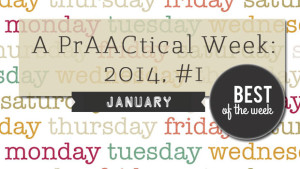
Well, it’s a prAACtical New Year and we are ushering in a few new tweaks in 2014. Among them, a weekly wrap-up. Here’s a look at our prAACtical week. Sunday: 10 Tips for Using a Natural Aided Language Board by Gail Van Tatenhove Monday: Tracking Early Communication Skills – A PrAACtical Resource (free download) Tuesday: It’s PrAACtically a New Year Wednesday: Ringing in the New Year with an AAC App Giveaway Thursday: A(nother) Year of Core Vocabulary Friday: Get Organized! Visual Schedule Apps If you’re looking for our Strategy of the Month post, stay tuned – those will be published on Mondays.
Filed under: PrAACtical Thinking
January 3, 2014
by Robin Parker -

It’s a New Year- 2014. Most of us use schedules– even when we know and accept the schedule. Many of us use schedules even though we do not have ‘transition issues’. However, ‘seeing’ our schedules often helps decrease anxiety and assure us the day will be ok because even if there are some ‘not so great’ activities, most of what we do is fairly good. Schedules can be created by using materials ranging from no-tech to high-tech. You can teach talking about past, present, and future events with schedules. You can also use schedules to teach core words. Here are 6 great visual schedule apps to help with ‘teching’ up the process. By ‘teching up’ the process, we also can add to independence so ALL learners can create their own schedules. We think it is important to let you know that ALL of the app developers provide information about... [Read More...]
Filed under: PrAACtical Thinking
Tagged With: Apps, visual schedules
January 2, 2014
by Carole Zangari -

It hardly seems possible that a year has gone by since we posted a Year of Core Words 2013. We’ve been so gratified by the feedback from professionals and parents who’ve put it to good use and followed month-by-month to focus on a dozen core words and get suggestions for additional practice. We were thrilled when others added symbols, created teaching materials, and adapted it for their own use. Today we’re back with the 2nd Year of Core Words, this time with 16 words/month. If you follow along, you’ll have covered 192 new core words by the end. Once again, we created 12 grids of core vocabulary words – one for each month of the year. Each grid has 16 cells labeled with core words. Plug in the AAC symbols that your client uses (e.g., PCS, SmartySymbols, Unity, Pixons, etc.), print, laminate, and keep them handy. Feel free to adapt... [Read More...]
Filed under: PrAACtical Thinking
Tagged With: core vocabulary, Year of Core Words
January 1, 2014
by Robin Parker -
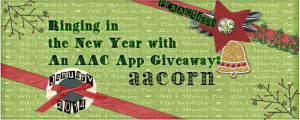
We are delighted to have the opportunity to ring in the New Year with a giveaway for an AAC app that’s gotten a lot of buzz lately. Aacorn is a comprehensive AAC app that brings a new twist to the AAC app options. aacorn- is a comprehensive AAC app designed to provide free flowing natural-sounding speech to children with who have limited or no ability to communicate verbally. AACORN learns to PREDICT what a child wants to say based on previously used utterances. Aacorn introduces the concept of a ‘word tree’. Words present themselves automatically, via a series of branching pathways. Aacorn is very intuitive for the general user. It is designed especially for children and the iPad You can choose between boy and girl US, UK, and Australian voices, speaking many hundreds of very expressive words that can be used to form an infinite number of sentences. Or you can use the built-in recording studio to record new voices.... [Read More...]
Filed under: PrAACtical Thinking
Tagged With: AAC app, aacorn, Giveaway
December 31, 2013
by Robin Parker -

It is just about 2014. Hard to believe another year is finished and we are moving on once again. Our wishes for 2014 are for ALL Learners to have access to: Aided Language Input Communication Displays that meet their needs Role Models Presumed Competence Core Word Instruction Fringe Word Instruction Friends Many Meaningful Language Experiences Frequent Communication Opportunities Fun Learning Our Wishes for ALL SLP’s and Educators to have access to: An Exciting and Stimulating Personal Learning Network (PLN) Appropriate Goals and Strategies Meaningful Language Experiences Role Models Laminator and Laminator Materials Literacy Materials Core Word Highlighter Tools, Page Fluffers & Spacers, Apps for Learning Language An AAC Philosophy Fun Teaching
Filed under: PrAACtical Thinking
Tagged With: new year
December 30, 2013
by Carole Zangari -
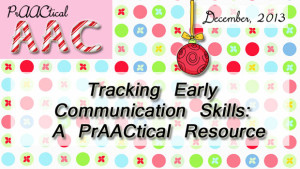
This month, we’ve been talking about ways to support beginning communicators, particularly those at the pre-intentional stage. In this brief post, we share a resource that you can use for graphing data. You can download the packet here or go to the e-Toolbox and look in the Downloads area. Direct Link to File – https://praacticalaac.org/?wpfb_dl=95
Filed under: PrAACtical Thinking
Tagged With: assessment, beginning communicator, download, preintentional communication
December 27, 2013
by Carole Zangari -

It’s been a wonderfully prAACtical year. Here’s a look back at our top 10 most popular posts. Anyone see any patterns? 🙂 How I Do It: Writing IEP Goals for Students Who Use AAC by Lauren Enders Teaching Core Vocabulary 5 Great Resources for Pre-Made Communication Boards Core Samples A Year Of Core Vocabulary Words AAC ‘Must Haves’ the the Classroom and Therapy Room Pivotal Skills for AAC Intervention: Aided Language Input How I Do It: AAC in the IEP by Lauren Enders Getting Started with Core Vocabulary More on Teaching Core Vocabulary
Filed under: PrAACtical Thinking
Tagged With: aided language input, communication boards, core vocabulary, IEP, Lauren Enders
December 26, 2013
by Carole Zangari -
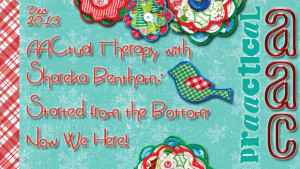
We’re so thrilled to have Shareka Bentham back as an AACtual Therapist, this time talking about her journey into high tech AAC. You can see other posts from Shareka here. One of our colleagues completed the AAC evaluation on a client of Shareka’s. While preparations for that evaluation were underway, we were fortunate enough to learn of an AAC device that was no longer needed. The family agreed to donate it to this little fellow, and that seems to have launched a whole chain of prAACtical events. Shareka takes it from here… Sadly, this is not the first step into my career as a rapping superstar, but more a description of my journey from ‘no tech’ to high tech in AAC use. If someone had told me a year ago that I would be showing off my skills on a high tech AAC device, and teaching children, parents, and teachers... [Read More...]
Filed under: PrAACtical Thinking
December 25, 2013
by Carole Zangari -
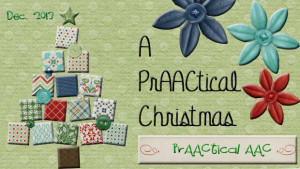
Filed under: PrAACtical Thinking
Tagged With: Christmas
December 24, 2013
by Robin Parker -

Use social narratives to explain happy upcoming events, stressful upcoming events, and out of the routine type events. Not only do social narratives help with understanding, but they can also help with ways to talk about activities and events. Use Aided Language Input (ALI) to model. It will show that even when there is a lot going on, AAC is still important and a high priority. Give out some AAC related presents to educators, professionals, families, and AAC users. Create the visual supports for holiday songs and poems. Or use a single step or sequential message device to record the songs, so everyone can sing together. You can even program the songs into high tech devices and have quite the good singing voice. Provide frequent communication opportunities for the AAC user to make choices, give opinions, rate activities and events, vent, ask questions, tell, and share information. Make talking photo... [Read More...]
Filed under: PrAACtical Thinking
Tagged With: AAC ideas








